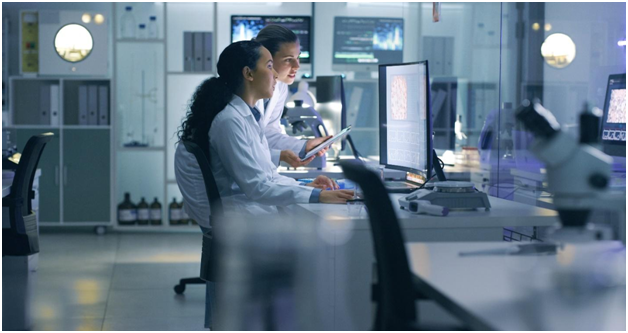The importance of technological integration in healthcare – for educators

With so much significant progress being made in the technology that supports healthcare provision, it can feel hard to keep up. Exciting new developments continue to emerge and be applied to different areas of the healthcare system in fresh and inspired ways on a near-weekly basis.
For this reason, it’s a real challenge to stay abreast of all the current – and potential – methods by which doctors, surgeons, nurses and other specialists can now consult, examine, diagnose and treat patients.
However, it is vital that as many practitioners and teachers within the field of medicine are able to understand and utilize these advanced methods as possible, as well as to impart their knowledge in these areas to professionals in training.
Technological integration in medicine is undergoing a revolution, but its efficacy will only extend as far as the healthcare education system allows.
Below, we examine just some of the existing and potential applications of new technology in healthcare, their benefits and possible pitfalls.
Later in this article, we will go on to explain why it is so important for healthcare education leaders to remain as informed about these advances as possible.
Some technological developments in medicine
Naturally, there are plenty of exciting advances being made in the areas of drug development and other disciplines related more closely to biology and chemistry.
However, while some of the technology we discuss below “crosses over” into those fields, the technology we will be exploring in this article lies chiefly within the fields of AI, robotics, machine learning and computing.
Below, we examine just a few of the new resources that are currently being – or will soon be – employed within the medical industry.
3D printing
3D printing has been an exciting cross-discipline tool for over a decade – and, with time, the technology has been honed, perfected and applied to an increasing number of precise applications.
Affordable, minutely crafted items may now be created swiftly and in a far more affordable manner than was possible in the past. These include prosthetics, braces and splints, surgical tools and even tissues.
This approach offers solutions to patients that are more budget friendly and accessible faster than the alternatives that were previously available to them, representing a significant step forward in healthcare equality.
Data sharing
It’s important to note that the sharing of data – including medical history – between hospitals, institutions and medical practices has been possible and indeed necessary for decades.
However, with cloud technology and the development of other remote capabilities, this has become easier and more accessible than ever.
Fast and effortless data sharing makes access to vital information and documentation far more straightforward “in the field.”
It aids the efforts of those administering aid to deployed individuals, medical professionals working in emergency rooms and disaster zones, and anyone tackling issues of patient consent, to name just a few.
Of course, with easier access to medical data, the majority of which is considered to be “sensitive information,” comes particular challenges.
Proper authorization methods must be employed at all times to ensure that the only people who are able to see and use the data in question are qualified and legally permitted to do so – and are only doing so for the explicit purpose of the task at hand.
Effective approaches to security are also vital, as breaches of medical data can have very serious consequences. This is particularly important now that legislation introduced in October 2022 now allows patients unrestricted access to their own healthcare data.
Finally, data sharing is only effective if the methods employed by the majority of medical organizations are compatible with one another.
When properly integrated, national – and even international – data networks can make consultation, diagnosis and treatment swift, smooth and effective, speeding up processes and winning patient trust.
However, if a patient’s information is stored in a system that is not “communicating” correctly, valuable time can be lost, and backlogs can grow.
Drone technology and autonomous delivery solutions
Access to vital medical resources, materials and substances – such as drugs and medication or even organs for transplant – has also become easier to achieve with the development of drone technology and autonomous delivery robots.
They reduce the cost of labor and arguably serve to prevent human error, introducing the potential for savings to be passed on to patients and for an improvement in medical equality both on a budgetary and location basis.
Of course, there is the potential for problems to arise when it comes to environmental factors, vandalism, accidents, acts of God, security and other issues when it comes to technology of this kind. However, more sophisticated updates to this technology are being developed all the time.
Remote access to healthcare
One of the major advances in healthcare technology in recent years has been the increase in remote consultations. This approach was first employed to a great extent during the COVID-19 lockdowns and periods of restriction of 2020 and 2021.
However, their benefits soon become obvious. Patients for whom in-person treatment is not considered vital can arrange a video consultation with a doctor or other specialist to determine the best course of action.
This means that the individual seeking advice or treatment is not necessarily required to travel, potentially making healthcare more affordable and accessible to more people. It may also improve wait times, reduce lateness and “free up” medical practitioners to see more urgent cases in person.
There are, of course, certain downsides to this approach. After all, not everyone can afford – or has access to or a sufficient understanding of – the technology required for activity of this kind.
What is more, basing a diagnosis on a purely visual consultation over a potentially unstable internet connection has the potential to lead to missed symptoms, so it is vital that medical specialists take extra care when handling appointments of this kind.
Improve and streamlined triage processes
Medical sectors in countries across the globe are regularly affected by personnel shortages or influxes of patients that outweigh the capacity of certain hospitals and medical practices, particularly in times of epidemic or pandemic.
On top of this, there are seasonal conditions that see the numbers requiring consultation or treatment rising and falling significantly. As a result, triage and the deployment of sufficient numbers of specialists can be a challenge to organize.
However, with the help of AI and automation, many of the elements of triage can be simplified. It is possible for patients to self-present online, where an automated system can then signpost them to the correct type or level of treatment to meet their needs.
Many times, remote triage is all that is needed to determine the best course of action, saving time that would have unnecessarily been spent going through physical checks using a practice’s integrated diagnostic system and other in-house equipment (much of which must also then be sanitized).
This, again, has the potential to reduce costs to both the sector and the patient, may reduce the pressure on waiting rooms and improve the speed at which individuals can be seen and treated by doctors and other specialists.
It may also allow for a greater level of personalization in medical care.
Of course, it is vital that medical professionals are trained to properly understand systems of this kind and that there is sufficient information available to aid patients of all backgrounds in their understanding of how the process works.
The shortcomings of new medical technology
The revolutionary new resources healthcare professionals are now able to access have the potential to work wonders in terms of time saving, cost reduction, diagnostic accuracy and patient satisfaction.
However, there are circumstances in which it may be dangerous to rely completely on their efficacy or to ignore their potential pitfalls.
We have explored a few possible issues that are applicable to specific types of technology above, but there is one aspect that is perhaps most important of all: the human element.
At present, few to no technological resources have the capacity to fully replace the strengths of a human doctor, nurse, surgeon or other specialist.
The presence of a “friendly face” and an effective bedside manner can make all the difference to patient satisfaction and comfort.
What’s more, a great deal of machine learning is based on probability and data, which means that “outside the box thinking” in terms of diagnosis and treatment is not yet achievable via this route.
Issues such as the atypical presentation of symptoms – or the intuition that allows a doctor to effectively interpret a patient’s particular way of describing a complaint – are currently beyond the reach of the majority of machines and computers.
The more emotional or “human” element of matters such as stress, fear and pain, and the complex personal matters relating to palliative and end-of-life care may also be too delicate for AI and automation to ever handle effectively.
For this reason, as things currently stand, it appears that the best way forward involves a combination of human and technological treatment, with the two sides working closely together to achieve the most effective integrated approaches for consultation, diagnosis and treatment.
The above are examples of just a few of the hundreds of ways in which technology continues to extend the capacity of healthcare institutions, professionals and techniques, with new and more advanced solutions being explored and introduced all the time.
Next, we’ll look at the role of healthcare educators when it comes to the understanding of new technology and its integration into everyday medical practice.
What can educators do?
Thanks to the overview above, we now know a little more about the current and near-future advances in technological integration within the medical industry – but why is it so important for educators to have the strongest possible grasp of this subject?
Passing on the knowledge
One of the most vital ways in which we can ensure that medical technology is as fully integrated, accessible and understood as possible is to properly educate all existing healthcare professionals and trainees about its operation, progress and potential pitfalls.
Naturally, in order to teach others about these complex matters, it is extremely important that teachers and educators in the field of medicine first develop an extensive understanding of these matters themselves.
It is the vital role of an educator or mentor to make material of this kind as digestible, processable and interesting to students as possible. They must also teach skills such as in-depth logical analysis, critical thinking and a willingness to continue to learn and research throughout one’s entire career.
One of the chief risks of working in healthcare education is the accidental circulation of flawed information or the passing-on of personal shortcomings and misgivings.
If a teacher or educator does not fully understand certain healthcare technology, it is likely that this knowledge gap – or, worse, distrust of certain resources – will be passed on to their students.
Teachers must instill confidence in those who learn from them. This is particularly the case in swiftly developing fields such as medical technology, as there will always be a lot to learn, and new professionals who have the mindset and skill set to take on new information on such subjects will always thrive.
In fact, as an educator, the act of teaching students to embrace and understand technological advances in medicine may well position you as a mentor to the developers of exciting new tools and approaches, making you instrumental in the furtherment of the field.
Employability
As is the case in a great number of sectors, newly minted medical professionals with an interest in – or with skills in the area of – new healthcare technologies will always be in high demand.
World-leading pharmaceutical companies, research departments of major hospitals and corporations that produce advanced medical equipment are always seeking new talent and a fresh perspective to help them develop new products and techniques.
They will also be on the lookout for educators to help with their in-house training and the development of future specialists. For this reason, teachers with the particular discipline of medical technology and its integration with the current healthcare system are highly valued.
If you are looking for a lucrative, challenging and rewarding niche in the medical world, becoming an educator in healthcare education and leadership – with a specialization in medical technology – is highly likely to land you in a very advanced role, benefitting from a sizable paycheck.
Troubleshooting and understanding shortcomings
Educators who are able to develop a complex understanding of medical technologies – and to stay abreast of new developments – are also instrumental in recognizing and tackling their shortcomings.
The more specialists are employed in troubleshooting, problem solving and developing solutions and “fixes” to existing problems, the more effective new healthcare tech will become.
In order to develop new tools that can be trusted in highly specialized scenarios, we need educators who have this minute level of understanding – and who can impart that knowledge to others.
In this way, educators who focus on technological integration in medicine are some of the most valuable professionals in the field.
Becoming an educator
The future looks bright for those interested in the field of innovation in healthcare and who wish to teach others about the vital developing technologies that promise to vastly improve the experience of both the provider and the patient.
There are exciting courses and advanced qualifications available that promise to give future medical educators all of the tools they require to forge a career of this kind.
For example, courses such as those available through Rockhurst University’s online Ed.D in Healthcare Education and Leadership program allows learners to develop these vital skills remotely online with one virtual capstone project, making qualifications of this kind far more accessible.
In conclusion
In order for the revolutionary advances in medical technology – including AI, robotics, machine learning, remote resources and data sharing – to be as effective as possible, and in order to smooth out teething issues and tackle potential pitfalls, we need passionate and knowledgeable educators operating on the national and international stage.
Not only must leaders in the medical education sector have a strong understanding of developments to date, but they must also have the willingness and capacity to continue their studies throughout their future career.
Tech in medicine continues to develop at a blistering rate, so those in charge of training the new generation of doctors, surgeons, nurses and other specialists must stay constantly abreast of world news, freshly published journals and ongoing research.
To this end, to be a medical educator with this particular discipline, one must have a passion for growing one’s knowledge, for questioning every new development and for exploring the potential application of every new piece of tech.
With the right educators on board, there will be endless possibilities for the improved affordability, equality and efficacy of medicine globally, thanks to the integration of the hugely promising new technologies that continue to be developed.



